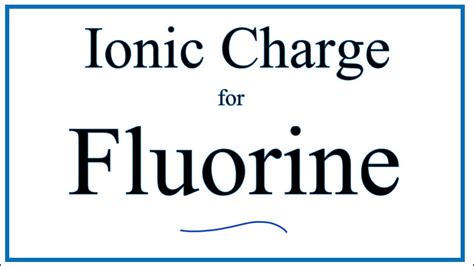Fluorine is a chemical element with the symbol F and atomic number 9. It is the lightest halogen and the 13th most abundant element in the Earth’s crust. Fluorine is a highly reactive element that forms compounds with most other elements.

What is the Charge of Fluorine?
Fluorine has a charge of -1. This means that it has one extra electron than it does protons. Fluorine is a nonmetal, and nonmetals typically have a negative charge.
Why Does Fluorine Have a Negative Charge?
Fluorine has a negative charge because it has more electrons than protons. Protons have a positive charge, and electrons have a negative charge. The number of protons in an atom determines its atomic number. The number of electrons in an atom determines its charge.
What are the Properties of Fluorine?
Fluorine is a pale yellow gas at room temperature. It is the most electronegative element, which means that it has a strong tendency to attract electrons. Fluorine is also the most reactive element, and it forms compounds with most other elements.
What are the Uses of Fluorine?
Fluorine is used in a variety of applications, including:
- Toothpaste: Fluoride is added to toothpaste to help prevent tooth decay. Fluoride helps to strengthen teeth and protect them from cavities.
- Water fluoridation: Fluoride is also added to public water supplies in many countries to help prevent tooth decay.
- Refrigerants: Fluorine is used in the production of refrigerants, which are used in air conditioners and refrigerators.
- Aerosols: Fluorine is used in the production of aerosols, such as hairspray and deodorant.
- Nuclear fuel: Fluorine is used in the production of nuclear fuel.
What are the Health Effects of Fluorine?
Fluorine is a toxic gas, and it can cause a variety of health problems, including:
- Eye irritation: Fluorine can cause eye irritation, including redness, swelling, and pain.
- Skin irritation: Fluorine can cause skin irritation, including redness, swelling, and burns.
- Respiratory problems: Fluorine can cause respiratory problems, including coughing, wheezing, and shortness of breath.
- Neurological problems: Fluorine can cause neurological problems, including headaches, dizziness, and seizures.
How Can I Protect Myself from Fluorine?
You can protect yourself from fluorine by:
- Avoiding exposure to fluorine gas: If you work with fluorine gas, be sure to wear proper protective equipment, such as a respirator and gloves.
- Drinking fluoridated water: Fluoride is added to public water supplies in many countries to help prevent tooth decay. Drinking fluoridated water is a safe and effective way to get the benefits of fluoride without exposing yourself to the risks of fluorine gas.
- Using fluoride toothpaste: Fluoride is added to toothpaste to help prevent tooth decay. Using fluoride toothpaste is a safe and effective way to get the benefits of fluoride without exposing yourself to the risks of fluorine gas.
Conclusion
Fluorine is a highly reactive element that has a negative charge. It is used in a variety of applications, including toothpaste, water fluoridation, refrigerants, aerosols, and nuclear fuel. Fluorine can cause a variety of health problems, so it is important to protect yourself from exposure to fluorine gas.
FAQs
1. What is the atomic number of fluorine?
The atomic number of fluorine is 9.
2. What is the electron configuration of fluorine?
The electron configuration of fluorine is 1s2 2s2 2p5.
3. What is the electronegativity of fluorine?
The electronegativity of fluorine is 4.0.
4. What is the ionization energy of fluorine?
The ionization energy of fluorine is 1680 kJ/mol.
5. What is the melting point of fluorine?
The melting point of fluorine is -219.6 °C.
6. What is the boiling point of fluorine?
The boiling point of fluorine is -188.1 °C.
